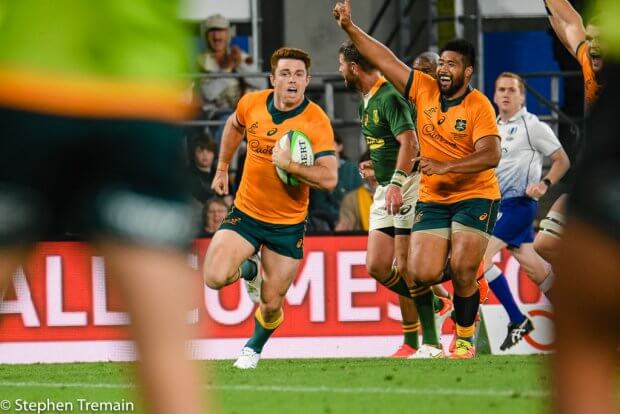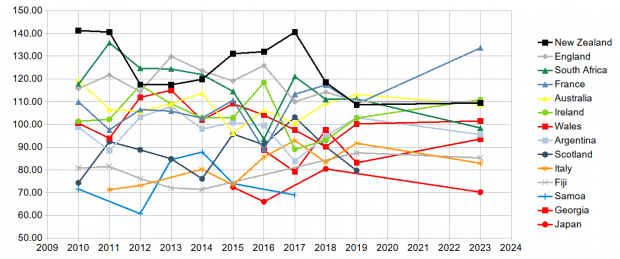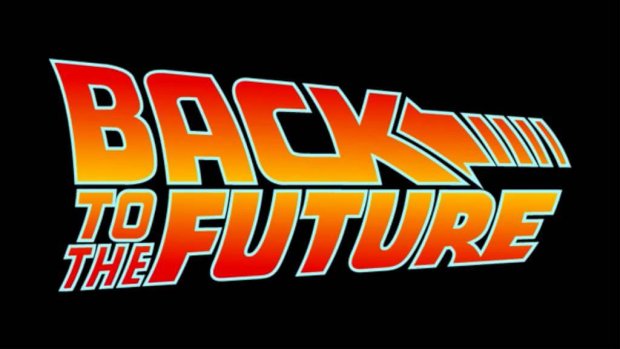Scheduled Website Maintenance
We’re currently in the process of moving to a new and improved server environment. During this transition, the website may experience brief interruptions or temporary outages.
We appreciate your patience while we complete this upgrade. Service will return to normal shortly, with improved performance and reliability.
Thank you for your understanding.
Ntamack out
As many outlets are reporting, Planet Rugby says that fly-half Romain Ntamack has been ruled out of the World Cup due to injury. The injury occurred in the weekend’s match against Scotland. Quoting from the article:
“Romain underwent a small hyperextension of the knee. We preferred to take him out of the game so there could be no further damage,” head coach Fabien Galthie said following the win. However, it looks as if their worst fears have come true, with the fly-half reportedly set to miss the entire tournament.
France Rugby have confirmed that Ntamack has ruptured cruciate ligaments in his left knee (ACL injury), which will sideline him for the tournament and a large chunk of Toulouse’s 2023/24 season.

WXV Match Schedule Announced
The full schedule is listed at the World Rugby web site.
The Wallaroos play the following matches:
- England 20th October (Friday)
- France 28th October (Saturday)
- Wales 3rd November (Friday)
It’s a cross pool format (half round robin might be another term for it), with the three top Six Nations teams playing the three top Pacific Four teams. The competition table will have all six teams in a single table and top of the table after all pool matches are complete is the winner.

The Value of Andrew Kellaway
Perhaps it’s not news, but Andrew Kellaway appears to have significant value for the Wallabies. Ben Smith (not the All Blacks Ben Smith – RugbyPass’s Ben Smith) has an analysis piece explaining why Andrew Kellaway is the key to Australia’s chances at the Rugby World Cup.
It is all about support lines. Ben uses still shots to illustrate a number of times in the last two games when AK found gaps due to his good reading and anticipation of the game. The article is well worth a look to see the detail of the case Ben makes.
However, Ben also explains that it is often being wasted.
There are parts to the Wallabies’ attacking game that are flourishing but the shared understanding is not there. They have creators in players like Kerevi, Nawaqanitawase and Petaia who can use their power, draw in defenders and find an offload. They have a genuine line-running fullback in Kellaway who needs to combine with these players as much as possible. Everyone else needs to map lines off Kellaway because he is going to get open two or three times a game and they absolutely must start finishing these breaks.
And finally:
Anyone running outside Kellaway has to quickly recognise that he will set them up, while the men inside need to be aware of their fullback looming in support. The Wallabies have found a mix of backline players with specific skills that complement each other, now it will just take time to perfect the chemistry.
Choosday Choo – Do Under 20s predict the Future?
Young people seem to know it all, but is it what they say or what they do that counts? And can their actions predict the future look like? To try to shed some light on this, I whipped up a program while driving home from work to calculate ratings for teams in the World Rugby U20 Championship and see what it might show. The following chart is the main result:

The chart above shows ratings for each national team derived from the World Rugby U20 Championship match results since its inception in 2010. The difference between the ratings of two teams gives the statistically probable points difference in a match (it is a least squares fit). So for example in 2010, New Zealand had a rating of 140, and South Africa 118, so the expected result is a win by New Zealand of 22 points. Only the difference matters – I set them to be centred on 100 so that some teams didn’t suffer the ignominy of having negative numbers. The numbers are similar to the Rugby Vision web site, but they represent the whole season rather than calculating the numbers on a rolling basis as Rugby Vision does.
I would think that if there was to be any predictive power in this chart, the grown up national team performance would follow this chart roughly speaking with a 6 or 7 year delay as the U20 players peak in their abilities. If you look at 2013 for example, the top 2 teams are England, and South Africa, and six years later these two teams competed in the 2019 World Cup final. England underperformed in the final – the chart says they had a 60% or so chance of winning. The 3rd and 4th teams in 2013, Wales and the All Blacks were the losing semi finalists in 2019.
Going back as far as the chart goes prior to the 2015 World Cup, we see that the All Blacks were dominant in 2010, but Australia was 2nd (only just) on the ratings. These two teams were the finalists in 2015, with New Zealand winning as expected. South Africa was 3rd, and England 4th, in 2010. England underperformed and was knocked out of its own world cup, but South Africa did finish 3rd.
Looking back six years before 2023, in 2017 there was a dominant All Blacks team, with South Africa 2nd and France 3rd. This appears to be a plausible finishing order for this years world cup. England was 4th in 2017, but again looks likely to underperform compared to the U20 team from six years prior.
Maybe there is something in this chart. So what does the future hold? Looking at 2019 on the chart, we can expect to win the Bledisloe Cup in 2025, or shortly after perhaps. You heard it here first on G&GR! The chart also says we couldn’t expect to win it at any time prior as far back as the chart goes. We can also expect a very competitive period in the Rugby Championship and top tier rugby in general around 2025.
2021 is missing from the chart due to COVID preventing play in the U20 Championship, so it’s difficult to say what U20 results say about the 2027 World Cup, but using the interpolated straight lines between 2019 and 2023, it’s the French as they go into a period of All Black style dominance. Australia should be quite competitive though, and maybe home advantage will help us to win our own World Cup.
There is reason to hope, and statistics never lie, except perhaps for England who appear to mostly underperform; do they need a better coach?

